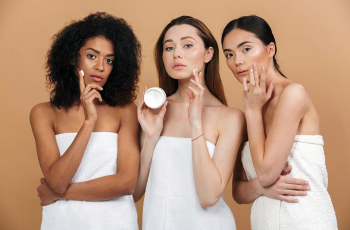You may have never heard of gluconolactone, and I can’t blame you if you’re complaining about having to go through another chemical peel. But I’d be lying if I said this clever PHA should be ignored. There’s a lot of magic packed into this humble skin ingredient, and you’ll be amazed at the difference your skin makes in its appearance, especially since gluconolactone is considered the gentlest acid on the market. So what’s it about this gentle skin giant that makes it stand out from the crowd? That’s exactly what we’re going to explore today.

What is gluconolactone?
As a member of the PHA family, gluconolactone is known as the gentlest chemical peel and has one of the largest molecular sizes, meaning it can’t penetrate deeply into the skin, making it a great choice for those with sensitive skin who still need to remove the buildup of dead skin cells. Despite its many benefits, gluconolactone is less likely to be found in active levels in skin care formulas compared to powerful AHA and BHA ingredients like glycolic and salicylic acids. However, gluconolactone provides impressive support for active ingredients by exfoliating the skin and locking in moisture. These moisturizing properties alone mean that introducing a PHA into your daily routine will benefit your skin, making it look and feel healthier.
What are the benefits of gluconolactone for skin?
You’ll find that gluconolactone is a multi-tasking ingredient that offers countless benefits to the skin and helps you achieve an overall flawless complexion. Here are some of the key benefits you can expect when you incorporate this PHA into your daily routine.
Provides Antioxidant Properties to Skin
Research has shown that the antioxidant properties of gluconolactone cannot be compared to other ingredients like vitamins C and E. However, gluconolactone is praised for its ability to neutralize free radicals and the damage they cause to the skin. It is also able to bind to free radicals, thereby encapsulating the damage caused by the sun, pollution, central heating, and other environmental stressors.
Exfoliates
Since gluconolactone is a PHA, it exfoliates the skin by breaking down the layers of dead skin cells that bind to the outer surface of the skin. When these cells build up, it can lead to flaky, dry patches and skin that is dull in tone and uneven in texture. You may also notice the appearance of breakouts like pimples and blackheads, which can become severe depending on your skin type. For example, oily skin can be more prone to breakouts due to excess sebum in the pores. Other sensitive and dry skin types, in general, cannot use any form of chemical peel without experiencing some form of skin irritation. However, as mentioned previously, gluconolactone is very gentle and, like all PHAs, can be used by people with skin allergies and skin issues such as eczema and rosacea. You may find that common side effects such as redness and irritation are less likely to occur than with stronger chemical peels such as glycolic and salicylic acids.
Hydrates the Skin
One of the unique properties of a PHA such as gluconolactone is that it is a humectant, i.e. it draws moisture from the surrounding areas of the face and locks it into the skin. This keeps your skin hydrated and looking plump. Fine lines and wrinkles are visibly reduced, and the complexion looks more youthful.
Because gluconolactone has a variety of skin benefits and is very gentle, it is easy to incorporate into your skincare routine. However, we must stress the importance of first patch testing any new products or ingredients that have not been applied to the skin. If you have any further concerns about using gluconolactone, it is best to consult a doctor or a trained professional.
How to Use Gluconolactone in Your Skin Care Routine
For some products, such as moisturizers, the formula is gentle enough to apply twice daily. It really depends on the specific products you want to use when introducing gluconolactone into your daily skincare routine. For stronger products, such as acid toners and exfoliants, you should limit the frequency of use as this may cause irritation, especially if you have sensitive skin type. Regardless of your skin type, you may find that your complexion benefits from alternating products with complementary ingredients that can be safely used with gluconolactone, such as hyaluronic acid and niacinamide. Stronger ingredients such as retinoids and vitamin C do not mix as well with gluconolactone and can be used at different times of the day, such as a vitamin C serum in the morning and a gluconolactone-rich serum in the evening.
Since this PHA is a humectant, you will find that combining it with a hydrating product such as a serum will increase the moisture content of your skin, giving your complexion an overall more hydrated, glowing complexion. Dry patches disappear, fine lines and wrinkles are smoothed, while the skin becomes more elastic and signs of sagging are reduced due to hydration.
What are the side effects of gluconolactone?
Since gluconolactone is a PHA, there are few or no side effects when using it in your daily life. We must remember that it is still an acid and should be used with caution, especially if you have sensitive skin or are prone to eczema and dermatitis flare-ups. If you use an acidic supplement rich in gluconolactone, you may still experience some redness and shimmering on your skin after use, but this should calm down within a few minutes. Dryness, stinging, and itching should not occur. However, if you find yourself experiencing these reactions, you should stop using the product immediately.


